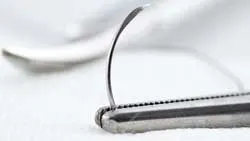Suture Choice for Today’s Veterinarian
Kelley Thieman Mankin, DVM, MS, DACVS (Small Animal), Texas A&M University

How can I fine-tune my suture choices?
In ancient India, surgeons closed incisions by painstakingly separating the mouth of ants or beetles from their body so the jaws could be used as a suture. In modern times, the variety of suture materials has become staggering, with hundreds of types, brands, and sizes. Because it is impractical to stock all suture types in a given clinic, it is important to select suture materials for the types of surgical procedures typically performed while trying to foresee future needs. The selection, therefore, can be daunting.
Overview
Absorbable vs Nonabsorbable
Absorbable sutures lose most of their tensile strength within 60 days,1 although they may retain some strength until they are fully absorbed. Nonabsorbable sutures retain tensile strength after 60 days and remain in tissue until they are removed. Absorbable sutures are most commonly used when the suture needs to be buried, and nonabsorbable sutures are often used when high tensile strength is needed for long periods.
Monofilament vs Multifilament
Monofilament sutures are made from a single strand, whereas multifilament sutures are made from several smaller strands that are braided or twisted together. In general, multifilament sutures have greater capillarity,2 increased pliability, and more tissue drag than monofilament sutures do.
Multifilament sutures are more likely to facilitate infection than smooth sutures because bacteria can colonize the gaps of the braided material.3 Therefore, many multifilament sutures are contraindicated for closure of contaminated wounds.
Sutures with greater capillarity are not recommended for use in skin or for penetration of a hollow viscus lumen.
Narrowing the Search
Several interrelated properties should be considered when selecting suture material for a specific procedure:
Absorbable versus nonabsorbable
Reactive versus nonreactive
Tensile strength
Ease of handling
Knot security
Capillarity (fluid absorption and wicking along the suture)
Other variables, such as the specific tissue being sutured and the healing speed, need to be considered as well.
Antimicrobial Impregnated
The Plus Sutures line recently introduced to the veterinary market, offers a selection of antimicrobial-impregnated sutures, including the triclosan-coated Vicryl Plus. Triclosan is a broad-spectrum antiseptic widely used in human personal care products.3 Triclosan-coated sutures have shown broad antimicrobial efficacy against many bacteria, including methicillin-resistant Staphylococcus aureus (MRSA).4-8
Methicillin-Resistant Staphylococcal Infections
A recent study in human surgical patients demonstrated greater than 50% reduction in surgical site infection rates when incisions were closed with triclosan-coated suture,9 but concordant results have not been demonstrated in veterinary patients.10 Triclosan has rarely been associated with contact dermatitis in humans,11 but no such effect has been noted in dogs. However, consideration should be given to this rare possibility.

Making the Selection
Monofilament Absorbable
Poliglecaprone 25 (Monocryl, ethicon360.com) is a rapidly absorbable suture. In the first week, it loses 40% to 50% of its tensile strength and 100% at 21 days postimplantation. This rapid absorption makes it a good choice for rapidly healing tissue, such as subcutaneous (SC) and urinary bladder tissue.12
Poliglecaprone 25 is a poor choice for tissue that is slow to regain tensile strength, such as fascia (linea alba) or tendons. The suture may induce less tissue reaction than polydioxanone (PDS, ethicon360.com)—especially in cats.
Polydioxanone and polyglyconate (Maxon, syneture.com) are slow to absorb. Both suture types lose approximately 40% of their tensile strength at 1 month postimplantation, and both are completely absorbed at approximately 180 days. Polydioxanone and polyglyconate are good suture choices for tissues such as fascia.
Multifilament Absorbable
Surgical gut, an inexpensive suture material, is absorbed at a rate that depends on suture exposure to chromium salts or aldehyde. Medium chromic gut is the most common example of multifilament absorbable suture. It loses tensile strength in approximately 20 days. Surgical gut is not recommended for closure of the GI tract or urinary bladder because of unpredictable absorption rates.
Polyglactin 910 (Vicryl, ethicon360.com) and polyglycolic acid (Dexon, syneture.com) are more slowly and predictably absorbed than is surgical gut. Both materials are absorbed completely within approximately 100 days. These sutures may lose tensile strength more rapidly if placed in an alkaline environment and are not recommended for use in the urinary bladder.
Polyglactin 910 and polyglycolic acid are soft, pliable, and easy to handle (the soft knotted ends can be buried easily). These sutures are appropriate for vessel ligation and SC tissue closure.
Monofilament Nonabsorbable
Polyamide (nylon) is mainly used as a monofilament but is available as a multifilament. Monofilament nylon degrades slowly; it loses only 30% of its tensile strength in 2 years. The monofilament suture is noncapillary and inexpensive and causes minimal tissue reaction. Nylon has poor handling properties and knot security. This type of suture is a good choice for skin closure.
Polypropylene (Prolene, ethicon360.com; Surgilene, surgitech.com) is not weakened by tissue enzymes. These sutures have a lower initial tensile strength than nylon does, but polypropylene is retained longer. It is the least thrombogenic suture and can be used to repair a rent in a large vessel using a small, noncutting needle. Polypropylene is also a good choice for fascia, ligament, and tendon reconstruction.
Multifilament Nonabsorbable
Silk is a common choice because of its good handling properties. This suture has high capillarity and should not be used to penetrate a hollow viscus. Although silk is considered a nonabsorbable suture, it degrades slowly (>720 days) by phagocytosis. Silk is a good choice for vessel ligation because it does not slip off vessels.
Polymerized caprolactam (ie, Vetafil [Supramid, supramid.com; Braunamid, aesculapusa.com]) is an inexpensive suture material with good handling properties and tensile strength. This suture, which is typically used for skin closure, is available on a reel with a chemical disinfectant but is not sterile and should not be buried or placed in a body cavity. Draining tracts have been associated with multifilament nonabsorbable sutures when used for ovariohysterectomy in dogs; the tracts originate at the ovarian pedicle and exit externally on the flank. The draining tracts must be treated by removal of the suture material on the ovarian pedicle.
Table: Suture Options by Tissue Type
Absorbable
Nonabsorbable
Closing Remarks
Suture selection can be simplified by giving consideration to the patient (eg, tissue being sutured, speed of healing) and the suture characteristics required for the procedure (eg, tensile strength, capillarity, persistence in tissue).